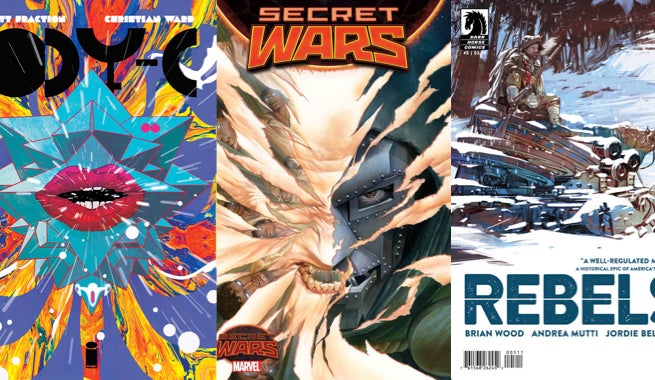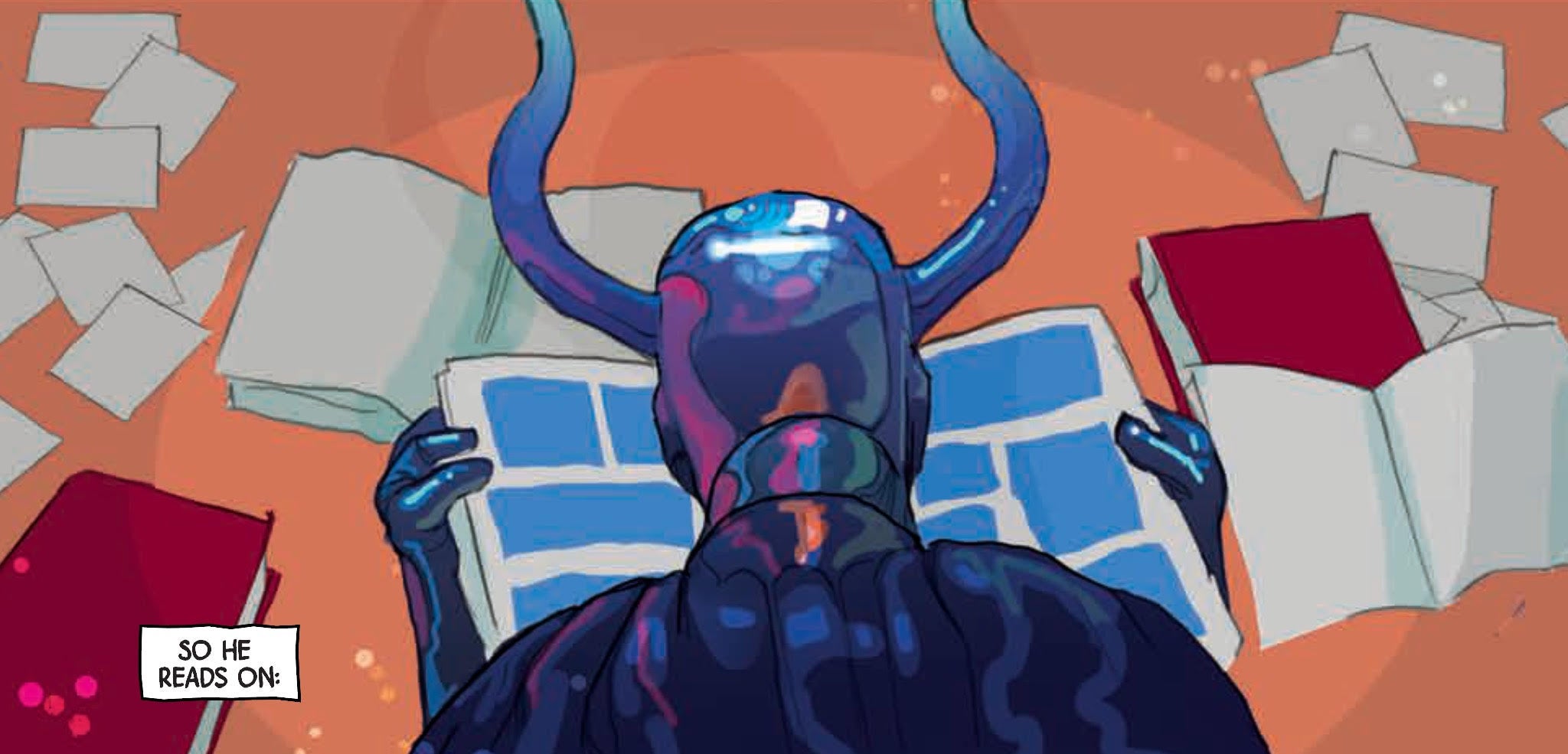Conflict lies at the heart of all great stories, so it’s no surprise that so many focus on war. The conflicts in war stories can take on a thousand different forms, ranging from the intense inner battles to the over-arching strategies of civilizations. Yet they all come with the big, obvious confrontations on the battlefield, soaked in blood. The comics in this week’s Fastball Feedback feature a wide variety of wars: a grandiose battle for the soul of the Marvel Universe, an inter-stellar voyage home from the greatest war ever fought, and the war that forged the United States of America. See how each one fared below.
Videos by ComicBook.com
Secret Wars #5
Written by Jonathan Hickman
Art by Esad Ribic
Colors by Ive Svorcina
Secret Wars #5 officially takes the series past its halfway point. All of the major players in this event have been introduced, and the stakes are clear. Now Jonathan Hickman and Esad Ribic must begin to cull everything that has been so carefully arranged together. This issue begins to take slow, but beautifully presented steps in that direction.
The conclusion of Secret Wars #4 gave the series a big push forward, putting the surviving heroes of Earth into play and dramatically changing God Doom’s status quo. The feeling that the central conflict of Secret Wars had finally arrived is largely squandered here. Hickman spends most of the issue reflecting on the death of Stephen Strange, and reflecting upon the origins of Battleworld. This much exposition included past the halfway point of the series slows the pacing dramatically. Much of what is said could have been or already was established much earlier in this story. It isn’t until the final few pages, which include the reintroduction of the Future Foundation that the story picks up its pace again. Yet the final page alone is exhilarating enough to make up for the missteps found in the middle of this issue.
Ribic makes Strange’s funeral and the events that follow feel more exciting through some truly fantastic staging. His presentation of Doom’s family and the Thors often feels like post-Renaissance paintings of royalty. Their dynamics and power inherent in how they fit together on the page. Ive Svorcina makes the power and potential found in a less-detailed scene midway through the issue shine in translucent light. Without his touch, it could have easily felt bland, but it instead feels almost overwhelming. And again, the manner in which Ribic and Svorcina present the final page, in framing and lighting it, it is simply incredible. You can feel your heart pick up a beat upon seeing it, as your inner child cries out in both delight and fear.
Secret Wars #5 may lose some of the series’ momentum, but the stakes and setting have never been more exciting. After years of planning and exposition, Hickman and Ribic possess a chessboard staged for an epic endgame. The final few pages of this issue will leave a pit in your stomach, and that anticipation reveals just how much potential there is still to be found in Secret Wars.
Grade: B-
Ody-C #6
Written by Matt Fraction
Art and Colors by Christian Ward
There are lots of ways to reimagine the classics. They are filled with ideas that beg to be examined and evaluated through our evolving understanding of art and society. ODY-C, a gender-bent retelling of The Odyssey set in space, should be a fascinating exercise. However, ODY-C #6 only makes it clearer that this series is more interested in obfuscation and egotism than any real attempt to discover meaning.
Matt Fraction has signaled that he both has a lot of things that he thinks are worth saying and that he has no idea how to say any of them in ODY-C #6. The issue is strained between a variety of purposes, none of which ever feel even half-realized. The inclusion of side-narratives from the The Odyssey show a slavish dedication to the original text, but their use and adjustment fails to add any unique value. It is worth asking what purpose each element in this issue serves. Does any of ODY-C #6 actually make a worthwhile commentary on the original text, gender roles, or the evolution of sex and religion? The answer is plainly no.
ODY-C #6 is in no way an engaging or merit-worthy story, but it is presented in breathtaking layouts and colors by Christian Ward. Each page is an individual achievement of Ward’s technique. There is a dreamy quality to his artwork that allows readers to sink into the panels and absorb the mood of each page. The narrative may not be clear, but the feeling its supposed to be conveying usually is. Ward composes entire pages in psychedelic, meta-narratives utilizing Euclidean shapes to enhance backgrounds and internal pages to create a narrative flow.
There may be some that find enough value in Ward’s presentation to stick with ODY-C. It’s somewhat painful seeing his skills strapped to this ship sinking under the weight of its own pretenses though. Beautiful woodwork and sails are not what is required to cross an ocean, and even the most astonishing artwork can’t cover the flaws of ODY-C.
Grade: C-
Rebels #5
Written by Brian Wood
Art by Andrea Mutti
Colors by Jordie Bellaire
Rebels #5 is the penultimate chapter of “A Well-Regulated Militia”, writer Brian Wood’s return to historical fiction with artist Andrea Mutti. As the end of the War for Independence draws nearer, so does the mission established in Rebels #4 as a ragged group of soldiers continue to drag cannons towards Boston. It is a harsh assignment made all the more brutal by a Northeastern winter.
Leading man Seth Abbott manages to be both a unique individual and an embodiment of many revered revolutionary values. His quiet nature and resourcefulness has always placed him as an outsider to most leaders in the war, and he receives a moment to shine in Rebels #5. In a rare bout of verbosity, Wood allows Abbott to make some very specific points about his role in the war that come as a triumph and serve to paint broader strokes about the American national identity. This long string of word balloons is as dense as Rebels ever reads, but each sentence is a natural joy.
Wood is smart enough to know when it is best to let his collaborators take the lead though. An early scene featuring Seth Abbott hunting is beautifully told. New York forests in snow are lit to be cold and isolating by Jordie Bellaire’s colors, and Mutti places each panel to guide the reader through Seth’s experience stalking these grounds. Even Jared K. Fletcher’s panels place white lettering against black boxes making them seem quiet as they blend into the artwork. It’s possible to delve into each scene like this, showing the level of craft on display from each artist involved in Rebels.
Rebels #5 works exceedingly well as both a visually compelling comics narrative and a fascinating piece of historical fiction. Wood, Mutti, and their collaborators have tapped into some of the core elements that make this period in American history mesmerizing on a personal level. The inclusion of famous battles and figures function as garnishment to the story of Seth Abbott, a story well worth reading.
Grade: B+
What did you think of this week’s comics? Sound off in the comments below.











